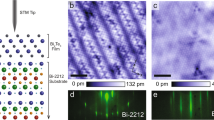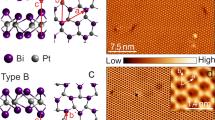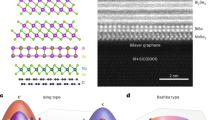Abstract
Topological insulators are a new class of material1,2, that exhibit robust gapless surface states protected by time-reversal symmetry3,4. The interplay of such symmetry-protected topological surface states and symmetry-broken states (for example, superconductivity) provides a platform for exploring new quantum phenomena and functionalities, such as one-dimensional chiral or helical gapless Majorana fermions5, and Majorana zero modes6 that may find application in fault-tolerant quantum computation7,8. Inducing superconductivity on the topological surface states is a prerequisite for their experimental realization1,2. Here, by growing high-quality topological insulator Bi2Se3 films on a d-wave superconductor Bi2Sr2CaCu2O8+δ using molecular beam epitaxy, we are able to induce high-temperature superconductivity on the surface states of Bi2Se3 films with a large pairing gap up to 15 meV. Interestingly, distinct from the d-wave pairing of Bi2Sr2CaCu2O8+δ, the proximity-induced gap on the surface states is nearly isotropic and consistent with predominant s-wave pairing as revealed by angle-resolved photoemission spectroscopy. Our work could provide a critical step towards the realization of the long sought Majorana zero modes.
This is a preview of subscription content, access via your institution
Access options
Subscribe to this journal
Receive 12 print issues and online access
$259.00 per year
only $21.58 per issue
Buy this article
- Purchase on SpringerLink
- Instant access to full article PDF
Prices may be subject to local taxes which are calculated during checkout




Similar content being viewed by others
References
Hasan, M. Z. & Kane, C. L. Colloquium: Topological insulators. Rev. Mod. Phys. 82, 3045–3067 (2010).
Qi, X-L. & Zhang, S. C. Topological insulators and superconductors. Rev. Mod. Phys. 83, 1057–1110 (2011).
Pedram, R. et al. Topological surface states protected from backscattering by chiral spin texture. Nature 460, 1106–1109 (2009).
Zhang, T. et al. Experimental demonstration of topolgoical surface states protected by time-reversal symmetry. Phys. Rev. Lett. 103, 266803 (2009).
Teo, J. C. Y. & Kane, C. L. Topological defects and gapless modes n insulators and superconductors. Phys. Rev. B 82, 115120 (2010).
Fu, L. & Kane, C. L. Superconducting proximity effect and Majorana fermions at the surface of a topological insulator. Phys. Rev. Lett. 100, 096407 (2008).
Kitaev, A. Y. Fault-tolerant quantum computation by anyons. Ann. Phys. 303, 2–30 (2003).
Nayak, C. et al. Non-Abelian anyons and topological quantum computation. Rev. Mod. Phys. 80, 1083–1159 (2008).
Mourik, V. et al. Signatures of Majorana fermions in hybrid superconductor–semiconductor nanowire devices. Science 336, 1003–1007 (2012).
Rokhinson, L. P. et al. The fractional a.c. Josephson effect in a semiconductor–superconductor nanowire as a signature of Majorana fermions. Nature Phys. 8, 795–799 (2012).
Deng, M. T. et al. Anomalous zero-bias conductance peak in a Nb-InSb nanowire-Nb hybrid device. Nano Lett. 12, 6414–6419 (2012).
Das, A. et al. Zero-bias peaks and splitting in an Al-InAs nanowire topological superconductor as a signature of Majorana fermions. Nature Phys. 8, 887–895 (2012).
Franz, M. Majorana’s wires. Nature Nanotech. 8, 149–152 (2013).
Wang, M. et al. The coexistence of superconductivity and topological order in the Bi2Se3 thin films. Science 336, 52–55 (2012).
De Gennes, P. G. Superconductivity of Metals and Alloys (Addison-Wesley, 1989).
Lucignano, P. et al. Advantages of using high-temperature superconductor heterostructures in the search for Majorana fermions. Phys. Rev. B 86, 144513 (2012).
Linder, J. et al. Unconventional superconductivity on a topological insulator. Phys. Rev. Lett. 104, 067001 (2010).
Zareapour, P. et al. Proximity-induced high temperature superconductivity in the topological insulators Bi2Se3 and Bi2Te3 . Nature Commun. 3, 1056 (2012).
Damascelli, A. et al. Angle-resolved photoemission studies of the cuprate superconductors. Rev. Mod. Phys. 75, 473–541 (2003).
Xia, Y. et al. Observation of a large-gap topological-insulator class with a single Dirac cone on the surface. Nature Phys. 5, 398–402 (2009).
Chen, Y. L. et al. Massive Dirac fermions on the surface of a magnetically doped topological insulator. Science 329, 659–662 (2010).
Zhang, Y. et al. Crossover of the three-dimensional topological insulator Bi2Se3 to the two-dimensional limit. Nature Phys. 6, 584–588 (2010).
Pan, Z-H. et al. Electronic structure of the topological insulator Bi2Se3 using angle-resolved photoemission spectroscopy: Evidence for a nearly full surface spin polarization. Phys. Rev. Lett. 106, 257004 (2011).
Shen, Z. X. et al. Anomalously large gap anisotropy in the A-B plane of Bi2Sr2CaCu2O8+δ . Phys. Rev. Lett. 70, 1553–1556 (1993).
Anderson, P. W. Theory of dirty superconductors. J. Phys. Chem. Solids 11, 26–30 (1959).
Gu, G. D. et al. Growth and superconductivity of Bi2.1Sr1.9Ca1.0(Cu1−yFey)2Ox single crystal. J. Cryst. Growth 137, 472–478 (1994).
Hudson, E. W. et al. Atomic-scale quasi-particle scattering resonances in Bi2Sr2CaCu2O8+δ . Science 285, 88–91 (1999).
Cheng, P. et al. Landau quantization of topological surface states in Bi2Se3 . Phys. Rev. Lett. 105, 076801 (2010).
Acknowledgements
We thank L. Fu, D-H. Lee, S. Kivelson and S. Zhang for useful discussions. This work is supported by the National Natural Science Foundation of China (grant No. 11274191 and 11025419) and Ministry of Education of China (20121087903, 20121778394). H.Y. and S.Z. acknowledges the support from the National Thousand Young Talents Program. E.W. acknowledges support from the Advanced Light Source doctoral fellowship programme. G.G. and Z.X. are supported by DOE under Contract No. DE-AC02-98CH10886. J.S. and R.Z. are supported by DOE Center for Emergent Superconductivity. The Advanced Light Source is supported by the Director, Office of Science, Office of Basic Energy Sciences, of the US Department of Energy under Contract No. DE-AC02-05CH11231.
Author information
Authors and Affiliations
Contributions
S.Z. and X.C. conceived and designed the experiments. H.D., Z.L., Y-F.L., K.Z. and L-G.Z. carried out MBE growth and STM measurements with assistance from S-H.J., L.W., K.H., X.M., X.C. and Q-K.X. Z.X., J.S., R.Z. and G.G. prepared the bulk Bi2212 samples. E.W., W.Y., A.V.F. and S.Z. performed ARPES measurements and data analysis. S.Z., X.C., H.Y. and Q-K.X. prepared the manuscript.
Corresponding authors
Ethics declarations
Competing interests
The authors declare no competing financial interests.
Supplementary information
Supplementary Information
Supplementary Information (PDF 1104 kb)
Rights and permissions
About this article
Cite this article
Wang, E., Ding, H., Fedorov, A. et al. Fully gapped topological surface states in Bi2Se3 films induced by a d-wave high-temperature superconductor. Nature Phys 9, 621–625 (2013). https://doi.org/10.1038/nphys2744
Received:
Accepted:
Published:
Issue date:
DOI: https://doi.org/10.1038/nphys2744
This article is cited by
-
Nonreciprocal charge transport in topological superconductor candidate Bi2Te3/PdTe2 heterostructure
npj Quantum Materials (2022)
-
Dual topological states in the layered titanium-based oxypnictide superconductor BaTi2Sb2O
npj Quantum Materials (2022)
-
Strong-coupling superconductivity with Tc ∼ 10.8 K induced by P doping in the topological semimetal Mo5Si3
Science China Materials (2022)
-
Investigations of proximity-induced superconductivity in the topological insulator Bi2Te3 by microRaman spectroscopy
Scientific Reports (2021)
-
Bulk superconductivity in the Dirac semimetal TlSb
Science China Physics, Mechanics & Astronomy (2021)



